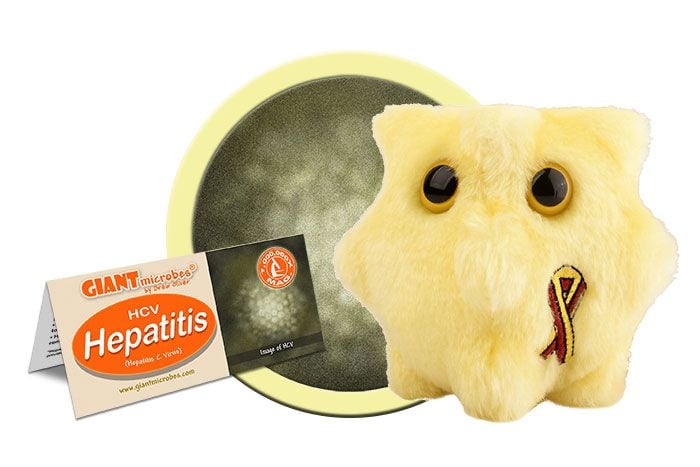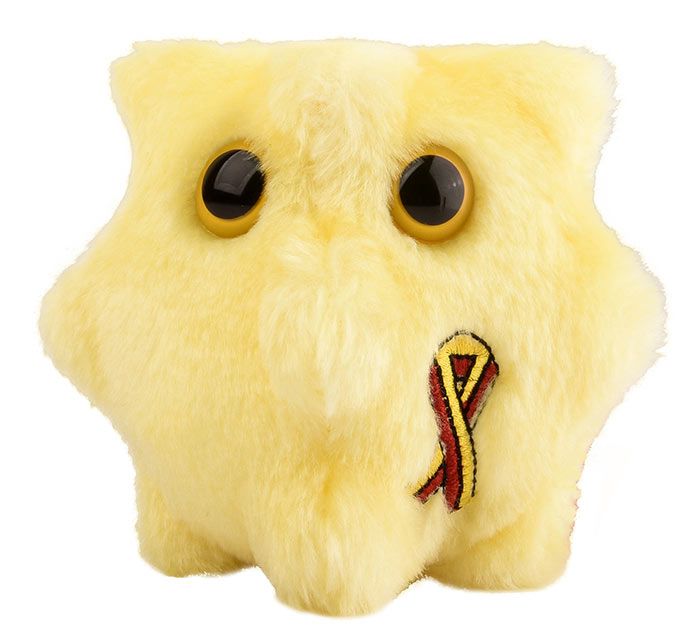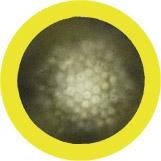Hepatitis (Hepatitis virus)
• HBV is transmitted in bodily fluids and can cause chronic liver disease
• HCV is perhaps the most dangerous: no vaccine is available
• HDV occurs only in the presence of HBV
• HEV is relatively mild and non-chronic
• HFV and HGV are newly identified; their connection with liver disease is debated
Product Details
Additional Information
| Sizes | Giantmicrobes are based on actual microbes, cells, organisms and other critters, only 1,000,000 times actual size! Gigantic (GG) 40-60cm XL (XL) 25-38cm Original (PD) 12-20cm Minis (MM) 5-10cm each Keychain (KC) 5-10cm with clip |
|---|---|
| Materials | Plush from all new materials. Stuffed with polyester fiber fill. Surface washable: sponge with water & soap, air dry. |
| Packaging | Each plush microbe includes a printed card with fun, educational and fascinating facts about the actual microbe or cell. |
| Safety | Every product meets or exceeds U.S. and European standards for safety. For ages 3 and up. |
All about Hepatitis (Hepatitis virus)
• HAV* is transmitted primarily by unsanitary food and water (frequently found in developing countries), or by direct contact with an infected person. It is non-chronic and relatively mild, though symptoms can include jaundice, fatigue, nausea, and fever. Vaccines are available.
• HBV is transmitted by bodily-fluids and is far more serious. Chronic liver disease caused by HBV results in death in 15-25% of chronically infected persons. Vaccines are available and are highly recommended.
• HCV is perhaps the most dangerous of the hepatitis viruses. Like HBV, it is transmitted by bodily-fluids. It causes severe liver damage in 70% of chronically infected persons; there is no vaccine available; and 80% of infected persons have no symptoms or signs of the disease – so not only are they at risk, but they can pass it to others unknowingly. Those at particular risk and for whom testing is advised include:
• I.V. drug users – most infections are due to illegal injection drug use
• Blood transfusion recipients before 1992 (prior to donor screening)
• People with undiagnosed liver problems
• Infants born to infected mothers
• HDV is similar to HBV, and only occurs in its presence, so vaccination-protection for HDV is, for practical purposes, available.
• HEV is relatively mild and non-chronic; it produces symptoms similar to HAV and is transmitted similarly. However, no vaccine is available.
• HFV and HGV are newly identified; their connection with liver disease remains controversial.
*Hepatitis viruses are typically identified by letters, e.g. HAV for Hepatitis A Virus. Virus information is provided by the Center for Disease Control.
| Description | This viral infection is mostly spread through contaminated needles or medical equipment, but it can spread through unsafe sex, unscreened blood transfusions, or childbirth. |
|---|
| Name | Hepatitis affects the liver, so the word comes from the Greek: Hepar=liver, Itis=inflammation. |
|---|
| Symptoms | The virus goes in the blood and affects the liver. The acute infection goes away on its own and the symptoms are minor- fever, nausea, abdominal discomfort, and jaundice. The chronic infection can cause serious liver damage and death. |
|---|
| Cure | It can be treated and sometimes successfully cured with antiviral medications. |
|---|
| History |
1989: Scientists at CDC and NIH discovered Hepatitis C. Big Outbreaks: 2002: 99 cancer patients in Nebraska got infected from unsanitary practices. 2008: 50,000 people exposed and >100 infected with Hepatitis C at a Las Vegas hospital. Recent Outbreaks: 2015: There have been growing rates of Hepatitis C and HIV in Indiana over the past 3 years, mostly due to injection drugs. |
|---|
| Fascinating Facts |
• This is one of the main causes of liver transplants. • Over 3 million people in the United States have this disease. |
|---|














